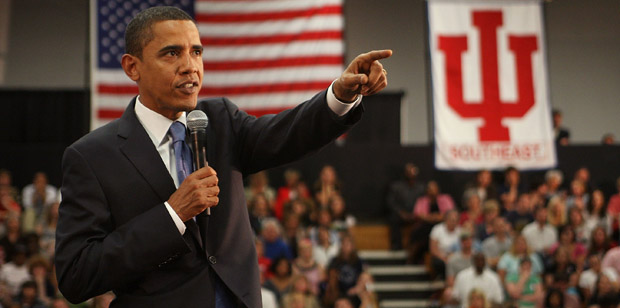How The Right College Loans To The Wrong Students Can Push Tuition Up

Scott Olson / Getty Images
Then-Senator Obama addresses a town hall forum during a presidential campaign stop at Indiana University Southeast in April 2008. As President, Obama has tried to ramp up the pressure on universities to keep costs low, threatening to cut financial aid to institutions unable to do so.
According to an old theory of educational economics, college financial aid becomes a vicious cycle: When more financial aid is made available to students, universities will hike tuition to make sure they pocket more of that money.
Research released this month has breathed new life into that disputed theory — at least in part.
Financial aid for relatively-affluent students often ends up raising the cost of college for everybody, writes researcher Andrew Gillen. Increasing financial aid to low-income students, on the other hand, does not push up tuition.
Gillen’s research tests the controversial “Bennett Hypothesis,” named for George H. W. Bush’s Secretary of Education William Bennett. Bennett first hypothesized a vicious cycle between increasing college tuition and increasing financial aid in 1987.
“Increases in financial aid in recent years have enabled colleges and universities blithely to raise their tuitions,” he famously wrote in The New York Times, “confident that Federal loan subsidies would help cushion the increase.”
Gillen tweaked some of the Bennett Hypothesis’ central tenets, and in an Inside Higher Ed commentary, he concludes:
Financial aid [can] improve college affordability in the short term. Targeting aid to low-income students, placing caps on tuition increases at public institutions, and even negative publicity for colleges that raise tuition too much can all help restrain tuition increases.
But… because competition among colleges is based on their relative standing, those colleges that exploit the opportunity to raise tuition when financial aid is increased will be able to improve relative to those that do not by hiring better professors, offering more aid to attract meritorious students, building state-of-the-art laboratories, etc. To avoid falling behind, even those colleges that initially resisted are forced to follow suit and raise tuition.
The key lesson is that we need to be very careful when (re)designing financial aid programs to avoid the very real danger that financial aid money will be captured by colleges without improving college affordability.
As Herbert London points out at Minding the Campus, colleges do have good reasons for pocketing the aid:
Every dollar given to a college goes through the turnstile of institutional improvement. Teaching loads could be reduced, new laboratories might be built, an academic “star” might be lured into a newly created position…. If the initial costs are borne by government aid, the future costs may put pressure on the administration to seek additional revenue, very often in the form of tuition increases.
| Federal Grants & Scholarships Received | |
|---|---|
| IU Bloomington | $153.0 million |
| Purdue-Main Campus | $119.1 million |
| Ball State | $77.4 million |
SOURCE: NCES |
|
The Obama administration recently unveiled a plan designed to tie eligibility for government financial aid to a college’s ability to help graduates earn good jobs with their degrees. The plan has come under fire from university administrators, who doubt the plan’s efficacy.
Some federal financial aid programs are currently more focused than others on helping poorer students pay for college.
The New America Foundation’s Jason Delisle points out Pell Grants, for example, “are overwhelmingly awarded to the lowest-income families.” But federally-subsidized Stafford Loans are a different story, as Delisle writes at Ed Money Watch:
About a quarter of all Subsidized Stafford loans made to dependent undergraduate students are provided to families with gross incomes of $80,000 and above. About 13 percent of the loans are made to dependent borrowers from families with incomes of $100,000 and higher…
While the needs-based formula that sets eligibility for Subsidized Stafford loans takes total family income into account, it also adjusts for cost of attendance. This means that middle and upper income borrowers can also qualify for these loans if they attend institutions with sufficiently high costs. It’s clear from the data that this provision means that Subsidized Stafford loans aren’t targeted to just students from low income families.
There are drawbacks to giving more money to lower-income students, even if Gillen’s right that it keeps tuition costs down. Arthur Hauptman points out increased funding for Pell Grants can hurt overall degree completion rates.
In the end, George Leef wonders whether Gillen’s points will fall on deaf ears. He writes at Minding the Campus:
“I applaud this work, but will it make any difference? After all, it is clear beyond any doubt that raising the minimum wage is counter-productive, but politicians keep doing that. Why should Gillen’s demonstration that the more politicians try to make college “affordable,” the more costly it becomes be any different?”
(h/t Joanne Jacobs)
